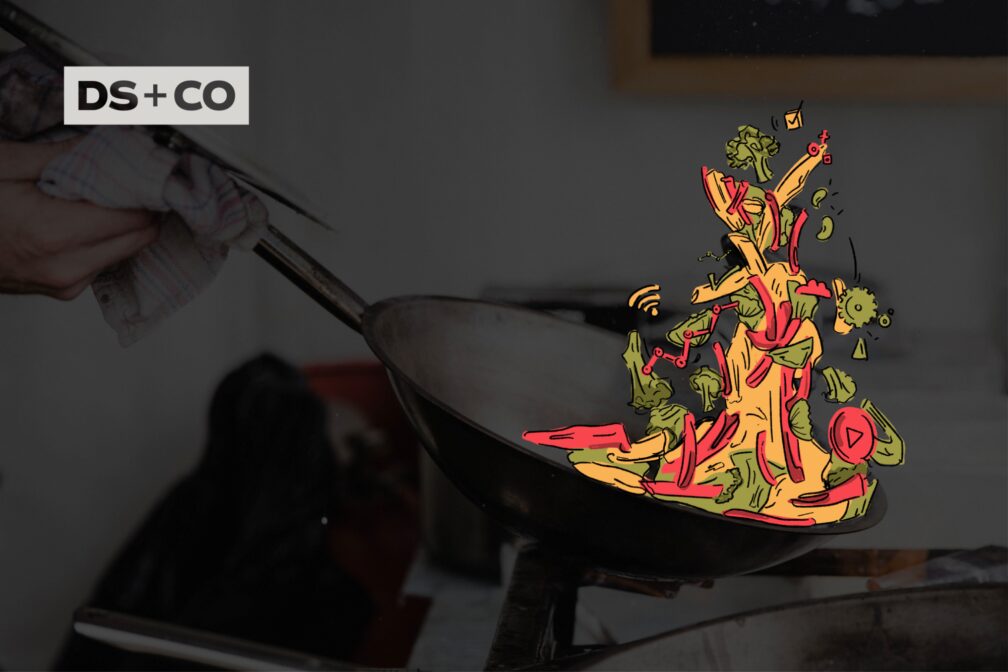Blog
Content + SEO

Content in 2022: What’s on the Menu
For marketers, content is the base of our food pyramid. We nourish our audiences with videos, blog articles, podcasts, direct mail pieces—you name it, we serve it. But you may be missing key ingredients necessary to elevate your content to a five-star review.
Sharpen your knives and let’s get cooking.
Leave Liver + Lima Beans Off the Kid’s Menu
Growing up, my mother’s favorite food was liver and onions, and my father’s was lima beans. Mine? Anything involving neither. Imagine dinner time: Both parents chowing down while my siblings and I figure out a way to clear our plates without actually eating anything. I’m exaggerating: Only four out of every 365 dinners each year included either dish, but three decades later, we haven’t forgotten the misery.
The same goes for your content. Fortunately for my parents, their dinner table was the only game in town, so it was liver and lima beans or no dessert. Unfortunately for you, you can’t completely control what your 2022 audience consumes, but your missteps can be just as memorable.
When you serve up content without regard for your audience, it’ll lack empathy no matter how good it is. And beyond being the content marketing buzz word du jour, empathy for your audience means feeding them content that has their problems at heart and solutions at its core. Are your liver and lima beans a splashy website or slick sizzle reel, when in reality a well-researched whitepaper is what your audience is actually craving?
There are so many ways to match content to the correct target audience, but doing so involves knowing three things: who your target audience is, what type of content they consume and where they consume it. The strategy behind each is just as important as the content itself—perhaps even more so. With a deep understanding of your audience, you're set up for content marketing success.
Use the Value Menu to Create Michelin-Star Cuisine
Content creator Danny Kim (@dannygrubs) has amassed millions of followers and exponentially more views by challenging chefs to create gourmet meals using fast-food menu items. These chefs are literally spinning chicken nuggets into foie gras, so why not try the same with your content?
Pennsylvania Lieutenant Gov. John Fetterman recently purchased a $300 Cameo from Nicole “Snooki” Polizzi in his bid for a US Senate seat. For just a few hundred dollars, his staff was able to create a viral moment for his campaign, garnering not only great engagement numbers, but countless earned media impressions across international publications. All this without having to bring in a single video editor!
Every grade-schooler with an iPad can technically make content these days. And the chefs in Kim’s videos know cheap content alone isn’t going to get the job done, so they add gourmet ingredients, too. For you, those gourmet additions are ingenuity and strategy.
The easiest way for you to incorporate this tasty tag-team is to repurpose your existing content—like heating up those leftovers. There are plenty of ways to combine ingenuity and strategy to create delicious content.
Use Fine China + Polish the Silverware
To create memorable dining experiences, restauranteurs don’t invest in only the food. Imagine sitting down to enjoy a molecular gastronomy tasting menu, only for it to be served on paper plates with plastic utensils. On the flip side, a mediocre meal can be elevated when it’s accompanied by white-glove service.
But the same way food is just one ingredient in a high-end dining experience, so too is content in your content marketing campaign.
In 2022, simply publishing content doesn’t equal a content marketing campaign. When digital marketing first came on the scene, marketers could get away with sending an email or posting organically to social media and see amazing results. Marketers rejoiced, assuming they could save money on printing large amounts of direct mail or investing in large traditional media buys.
Fast-forward to today and direct mail pieces have significantly better conversion rates than email and organic social. The Data & Marketing Association reported direct mail conversion rates of 9% in 2021. When was the last time you saw that return on an email campaign?
I’m not advocating for you to abandon digital for print—far from it. The takeaway is that the cost of stamp is an investment in content promotion. But unlike rising postage costs, you don’t need to put a lot of money behind your content for it to be seen. Investing as little as $100 in social media advertising ensures your content will at least be seen in a cluttered landscape. This type of budget is crumbs compared to the thousands you most likely spent creating a piece of content.
Much like diners needing to factor the tip into the cost of a meal, you need to start factoring promotional costs into your content budget.
And now that you’re hungry for good content, reach out to our chefs at DS+CO to help craft a menu for your next marketing campaign.
Amber Webb